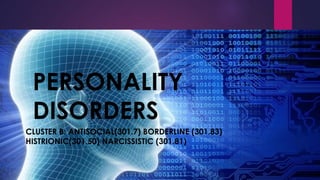
PERSONALITY DISORDERS DSM5
- 1. PERSONALITY DISORDERS CLUSTER B: ANTISOCIAL(301.7) BORDERLINE (301.83) HISTRIONIC(301.50) NARCISSISTIC (301.81)
- 2. Introduction to Personality Disorders What is Personality Disorders: A personality disorder is a type of mental disorder in which you have a rigid and unhealthy pattern of thinking, functioning and behaving. A person with a personality disorder has trouble perceiving and relating to situations and to people. This causes significant problems and limitations in relationships, social encounters, work and school. Personality disorders usually begin in the teenage years or early adulthood. There are many types of personality disorders. Some types may become less obvious throughout middle age.
- 3. Introduction to Personality Disorders continue Personality is the combination of thoughts, emotions and behaviors that makes you unique. It's the way you view, understand and relate to the outside world, as well as how you see yourself. Personality forms during childhood, shaped through an interaction of two factors: Your genes. Certain personality traits may be passed on to you by your parents through inherited genes. These traits are sometimes called your temperament. Your environment. This involves the surroundings you grew up in, events that occurred, and relationships with family members and others. Personality disorders are thought to be caused by a combination of these genetic and environmental influences. Your genes may make you vulnerable to developing a personality disorder, and a life situation may trigger the actual development.
- 4. What are the symptoms of Personality Disorders What are the symptoms of Personality Disorder? There are several types of personality disorders that are grouped into three clusters, based on similar characteristics and symptoms. Many people with one personality disorder may also have signs and symptoms of at least one additional personality disorder.
- 5. Personality disorders are grouped into three clusters: Cluster (A) personality disorders are characterized by odd, eccentric thinking or behavior. They include paranoid personality disorder, schizoid personality disorder and schizotypal personality disorder. Cluster (B) personality disorders are characterized by dramatic, overly emotional or unpredictable thinking or behavior. They include antisocial personality disorder, borderline personality disorder, histrionic personality disorder and narcissistic personality disorder.
- 6. Personality disorders are grouped into three clusters: continue Cluster C personality disorders are characterized by anxious, fearful thinking or behavior. They include avoidant personality disorder, dependent personality disorder and obsessive- compulsive personality disorder. It's not necessary to exhibit all the signs and symptoms listed for a disorder to be diagnosed.
- 7. Cluster (B) Personality Disorders: Antisocial, Borderline, Histrionic, and Narcissistic
- 8. Antisocial Antisocial Personality Disorder (DSM 5: 301.7): Persons afflicted with ASPD violate social norms and, specifically, behaviors that are prohibited by the criminal code. ASPD may shoplift, break and enter households. Assault with weapons, steal automobiles, or even commit murder. Not all persons with ASPD will commit all of these behaviors. Several serial killers were diagnose with ASPD such as Ted Bundy, John Wayne Gacy,
- 9. DSM 5 Diagnostic Criteria for Anti- Social Disorder(301.7) A pervasive pattern of disregard for and violation of the rights of others, occurring since age 15 as indicated by three or more of the following. Disregard for others' needs or feelings Persistent lying, stealing, using aliases, conning others Recurring problems with the law Repeated violation of the rights of others Aggressive, often violent behavior Disregard for the safety of self or others Impulsive behavior Consistently irresponsible Lack of remorse for behavior
